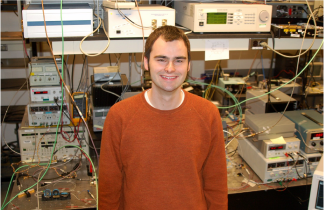 (Left: beam profile in one of Mordechai Segev's 2D photonic crystal lattices. The transverse disorder increases from c) to e). From Schwartz, Segev et al)
(Left: beam profile in one of Mordechai Segev's 2D photonic crystal lattices. The transverse disorder increases from c) to e). From Schwartz, Segev et al)This year's CLEO plenary sessions were exceptional. Monday evening hosted talks by Donald Keck, who pioneered the first low-loss optical fiber and James Fujimoto, renown for developing optical coherence tomography. Wednesday morning's plenary followed with exhilarating work (I'm serious, not just blogger hyperbole here) on photonic crystals. Even the awards were exciting. Amnon Yariv, responsible for the creation of the distributed feedback laser, and whose book "Optical Electronics in Modern Communication," I safeguard as one of the most helpful optics texts on my shelf, was presented with the 2011 IEEE Photonics Award. In his acceptance speech, he spoke briefly of his emigration to the United States from Israel 60 years ago. The freighter that carried him, other passengers, and iron ore across the Atlantic, made entry in none other than the city of Baltimore. Yariv, reminisced about his first meal after landing in a gritty, industrial, 1950s Baltimore-a ham sandwich (his first ever)!
After the awards, the plenary speakers Mordechai (Moti) Segev and Susumu Noda spoke about their respective work on photonic crystals. Segev, a charismatic speaker, setup a beautiful story addressing a fundamental understanding of periodic and random structures via photonic lattices. He specifically spoke about work on Anderson Localization of Photons, the optical analog to Anderson's Theory for Localization of electron's in a crystal lattice. By introducing disorder into a 2D photonic lattice, Segev was able to constructively interfere light over a small area, and destructively interfere light everywhere else. Diffraction is thwarted, analogous to how diffusion is thwarted by the interference of electron waves for Anderson Localization in a crystal lattice (see figure above). Check out Frank Kuo's February 26, blogpost with more details describing this work.
Segev's group of course has pushed this work further, and into stranger directions. In contrast to confinement, Segev's group found that they could make a beam expand faster than diffraction, hyper-transport. One reason this work is so beautiful is that the theory and phenomena for photonic lattices can be borrowed from crystal lattices in condensed matter and visa-versa. The equations are the same, you just need to change the variables and some good creativity. In 2008, Roati et al leveraged work from Anderson Localization in photonic lattices to demonstrate Anderson Localization for the first time using matter waves. This makes me wonder about a designing a crystal structure with say hyper-diffusion? With a sharp mind and good imagination, the possibilities seem endless.
Segev does a fantastic job framing his work romantically. Though the devices his group makes have great practical implications, it is all through the guise of exploring the nature of world. Segev helps remind us why we became interested in science in the first place, for the thrill of exploration and finding answers, to generate new questions, and to pursue things because they are beautiful.
Segev was a tough act to follow, but Noda came through. After Segev's nice setup, Noda showed one impressive photonic crystal device after the other. Here is a list of some of the groundbreaking devices he has made:
-Nano-cavities with Q > 40,000
-Inhibition of spontaneous emission
-Light that can make right angle turns
-Slowing or stopping light with probe pulses
-Novel gates for quantum computing
-Small beam-steering devices
-High-efficiency, high power single wavelength emitters
-Creation of unique beam patterns for applications like optical trapping of non-dielectric particles
-Sub-wavelength focusing of beams
-Thermal emission control (shaping and redistribution of blackbody spectra)
Again, for details on the physics behind some of these devices, see Frank Kuo's February 26, blogpost. I left this plenary session inspired, ready to get into the lab to get some work done, and strangely with the craving for a Baltimore ham sandwich.

No comments:
Post a Comment